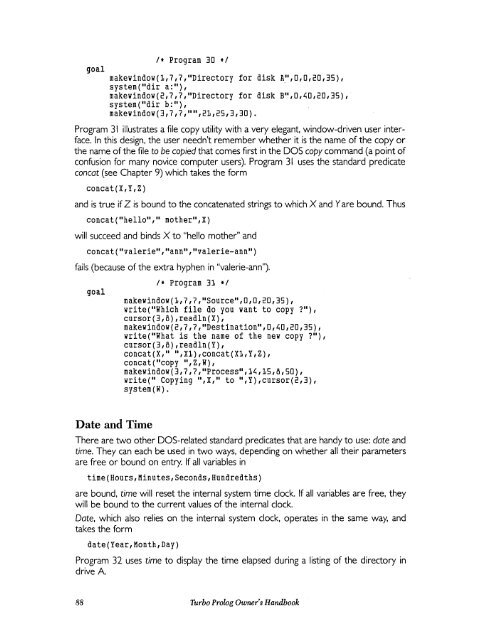Turbo Prolog
Turbo Prolog
Turbo Prolog
You also want an ePaper? Increase the reach of your titles
YUMPU automatically turns print PDFs into web optimized ePapers that Google loves.
goal<br />
1* Program 30 *1<br />
makewindow(l,7,7,"Directory for disk AII,o,o,20,3S),<br />
system("dir a:"),<br />
makewindow(2,7,7,"Directory for disk B",o,L;o,2o,3S),<br />
system("dir b:"),<br />
makewindow(3,7,7,"I,21,2S,3,30).<br />
Program 31 illustrates a file copy utility with a very elegant, window-driven user interface.<br />
In this design, the user needn't remember whether it is the name of the copy or<br />
the name of the file to be copied that comes first in the DOS copy command (a point of<br />
confusion for many novice computer users). Program 31 uses the standard predicate<br />
concat (see Chapter 9) which takes the form<br />
concat(X,y,Z)<br />
and is true if Z is bound to the concatenated strings to which X and Yare bound. Thus<br />
concat("hello"," mother",X)<br />
will succeed and binds X to "hello mother" and<br />
concat("valerie","ann","valerie-ann")<br />
fails (because of the extra hyphen in "valerie-ann").<br />
goal<br />
Date and Time<br />
1* Program 31 *1<br />
makewindow(l,7,7,ISource",o,o,2o,3S),<br />
write("Which file do you want to copy ?"),<br />
cursor(3,B),readln(X),<br />
makewindow(2,7,7,IDestination",o,L;o,2o,3S),<br />
write("What is the name of the new copy ?"),<br />
cursor(3,B),readln(Y),<br />
concat(X," ",Xl) ,concat(Xl, Y, Z),<br />
concat("copy ",Z,W),<br />
makewindow(3,7,7,IProcess",M,lS,B,So),<br />
write(" Copying ",X," to ",Y),cursor(2,3),<br />
system(W) .<br />
There are two other DOS-related standard predicates that are handy to use: date and<br />
time. They can each be used in two ways, depending on whether all their parameters<br />
are free or bound on entry. If all variables in<br />
time(Hours,Minutes,Seconds,Hundredths)<br />
are bound, time will reset the internal system time clock. If all variables are free, they<br />
will be bound to the current values of the internal clock.<br />
Date, which also relies on the internal system clock, operates in the same way, and<br />
takes the form<br />
date(Year,Month,Day)<br />
Program 32 uses time to display the time elapsed during a listing of the directory in<br />
drive A.<br />
88 <strong>Turbo</strong> <strong>Prolog</strong> Owner's Handbook


